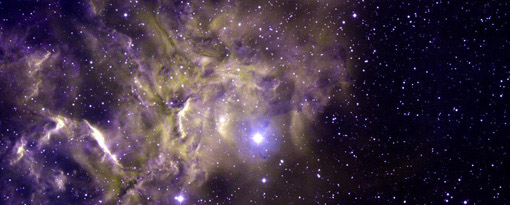Deuterium Abundance
The stability of deuterium is one of the "windows of creation" that are critical in the standard "big bang" model. But deuterium tends to fuse quickly to form helium, so the abundance of deuterium in the present universe is a sensitive probe into the processes that occurred in the early universe. Deuterium, which contains one proton and one neutron, was created a few minutes after the Big Bang. Its presence today in the local universe serves as a tracer for star creation and galaxy building throughout the eons. This is because any deuterium in stars tends to be quickly fused into helium. So nearly all the deuterium seen today is "pure," having never been burned by stars. Knowing how much deuterium was created in the Big Bang and how much still exists today allows scientists to estimate how much gas has been used to create stars.
Some light has been shed on the behavior of deuterium by observations from the Far Ultraviolet Spectroscopic Explorer (FUSE).

Credit: T.A. Rector and B.A. Wolpa, NOAO, AURA, and NSF
This is a false-color image of the star AE Aurigae (bright source of light slightly off center of image) embedded in a region of space containing smoke-like filaments of carbon-rich dust grains, a common phenomenon. Such dust might be hiding deuterium, an isotope of hydrogen, and hindering astronomers' efforts to study star and galaxy formation. The FUSE satellite has surveyed the local deuterium concentration in the galaxy and found far more than expected. It may be that the hot star vaporized some of the deuterium from dust grains where it was "hiding".
Deuterium's spectral fingerprint in the ultraviolet allows it to be distinguished from the normal isotope of hydrogen by FUSE's spectrometer. Primordial deuterium concentrations of about 27 parts per million hydrogen atoms have been estimated by various non-FUSE studies. Recently NASA's Wilkinson Microwave Anisotropy Probe confirmed this approximation. But measurements in our galactic neighborhood have shown large variations in the measured deuterium. FUSE detected levels of 15 ppm in our neighborhood and as low as 5 ppm in some other locations. The peak levels of deuterium measured by FUSE in our galaxy were about 23 ppm, which still needs explanation in comparison to the modeled 27 ppm, but models for how the lower concentrations where produced have been proposed.
In 2003, Bruce Draine of Princeton University, a team member on the new FUSE study, developed computer models that showed how deuterium, compared to hydrogen, might preferentially bind to interstellar dust grains, changing from an easily detectable gaseous form to an unobservable solid form. The new FUSE data strongly support this theory. In regions that remain undisturbed for long periods, such as the "local bubble" around our sun a few hundred light-years across, deuterium atoms systematically leave the gas phase and replace normal hydrogen atoms in dust grains. FUSE cannot detect this non-gaseous form, which explains the low detection level of 15 parts per million hydrogen atoms in our neighborhood and values as low as 5 parts per million elsewhere. When a region is disturbed by a supernova or hot stars, dust grains are vaporized, releasing deuterium atoms back into a gas phase. FUSE detects high deuterium levels in such regions.
"The peak galactic detection levels are likely close to the real total deuterium abundance in the Milky Way, with the rest of it in hiding, not destroyed," said Warren Moos of Johns Hopkins University in Baltimore, FUSE Principal Investigator and co-author on the report in the August 20, 2006 issue of The Astrophysical Journal.
If the peak levels are 23 parts per million, this implies that either significantly less material has been converted to helium and heavier elements in stars or that much more primordial gas has rained down onto our galaxy over its lifetime than had been thought. In either case, our models of the chemical evolution of the Milky Way galaxy will have to be revised significantly to explain this new result, said George Sonneborn of NASA Goddard Space Flight Center in Greenbelt, Md., co-author and mission project scientist.
Sources
| HyperPhysics***** Astrophysics | R Nave |